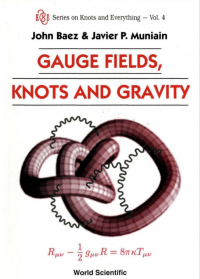Baez, Muniain: Gauge Fields, Knots and Gravity
Why is it interesting?

There are almost surely hundreds of precise textbooks on differential geometry and fiber bundles, many bringing to mind the observation by C.N. Yang that “There are only two kinds of math books. Those you cannot read beyond the first sentence, and those you cannot read beyond the first page.” On the other end of the spectrum are the “[x] for physicists” books which often treat their chosen material intuitively but not precisely enough to be useful in calculating or deriving anything. The chief strength of this book is its ability to do both well, and in a non-cumbersome formalism. Concepts are explained in a clear, easy to read manner and then connected to precise definitions written in a useful formalism. Any one of these three can make for a useful book, but Baez and Muniain set a new standard by offering all three. And over 300 exercises.Joseph M. Renes
Reading Notes/Summaries
- A great summary of Gauge, Fields, Knots and Gravity was published by Michael Nielsen
Solutions to Exercises
Part I:
- Exercise 1
-
Q: Let $\vec{k}\in\mathbb R^3$ and lt $\omega=|\vec{k}|$. Fix $\vec{E}\in\mathbb{C}^3$ with
$\vec{k}\cdot\vec{E}=0$ and $\vec{k}\times\vec{E}=i\omega\vec{E}$. Show that
$\vec{\mathcal{E}}(t,\vec{x})=\vec{E}e^{-i(\omega t-\vec{k}\cdot\vec{x})}$ satisfies the
vacuum Maxwell equations.
A:
- Exercise 2
-
Q: Given a Lie group $G$, define its identity component $G_0$ to be the connected component
containing the identity element. Show that the identity component of any Lie group is a subgroup, and a Lie
group in its own right.
A: Suppose we have a path from the identity to $g\in G_0$. Now map this path to a new path by multiplying each element by $h\in G_0$. This path starts at $h$ and since the mapping is continuous, must remain in $G_0$. (Otherwise, smoothly mapping the group manifold to $\mathbb R^n$ would show a discontinuity at some point.) Thus $hg\in G_0$ for all $h,g\in G_0$. There's a certain tension between having a smooth manifold with disconnected pieces — given a map from the the manifold to itself, one must take care that it does not have a discontinuous action, mapping some points in one component to another component. When this map is an element of the group, this requirement makes $G_0$ into a subgroup.
Part II:
- Exercise 1
-
Q:Given a Lie group $G$, define its identity component $G_0$ to be the connected component
containing the identity element. Show that the identity component of any Lie group is a subgroup, and a Lie
group in its own right.
A: Suppose we have a path from the identity to $g\in G_0$. Now map this path to a new path by multiplying each element by $h\in G_0$. This path starts at $h$ and since the mapping is continuous, must remain in $G_0$. (Otherwise, smoothly mapping the group manifold to $\R^n$ would show a discontinuity at some point.) Thus $hg\in G_0$ for all $h,g\in G_0$.
There's a certain tension between having a smooth manifold with disconnected pieces — given a map from the the manifold to itself, one must take care that it does not have a discontinuous action, mapping some points in one component to another component. When this map is an element of the group, this requirement makes $G_0$ into a subgroup.
Source: Solutions to Exercises in Gauge Fields, Knots and Gravity by Joseph M. Renes licensed under a Creative Commons Attribution 4.0 Licence.
See also:
- Solutions by Joseph M. Renes. ("Solutions to nearly all of the exercises in Part I, many of them in Part II, and none in Part III")
- https://ncatlab.org/brucebartlett/published/BaezMunian. (Solutions to all exercises in Part I and Part II.)